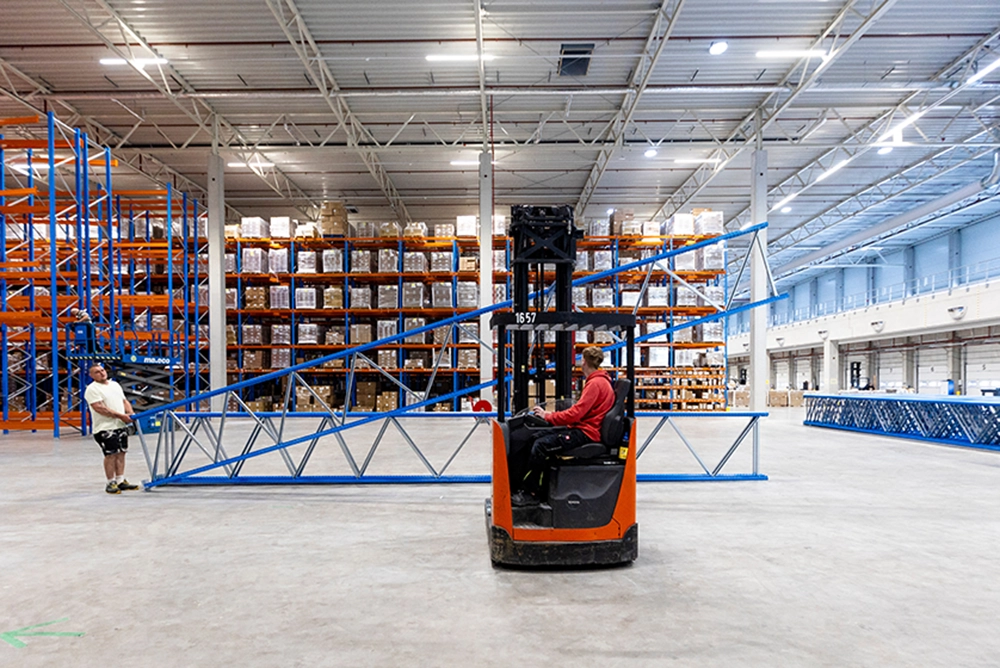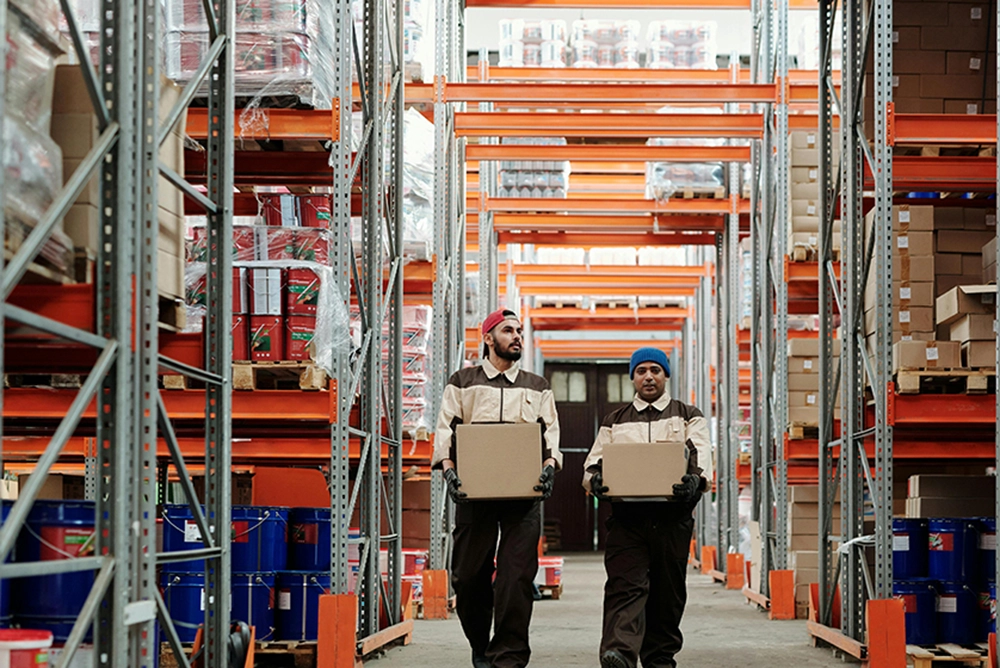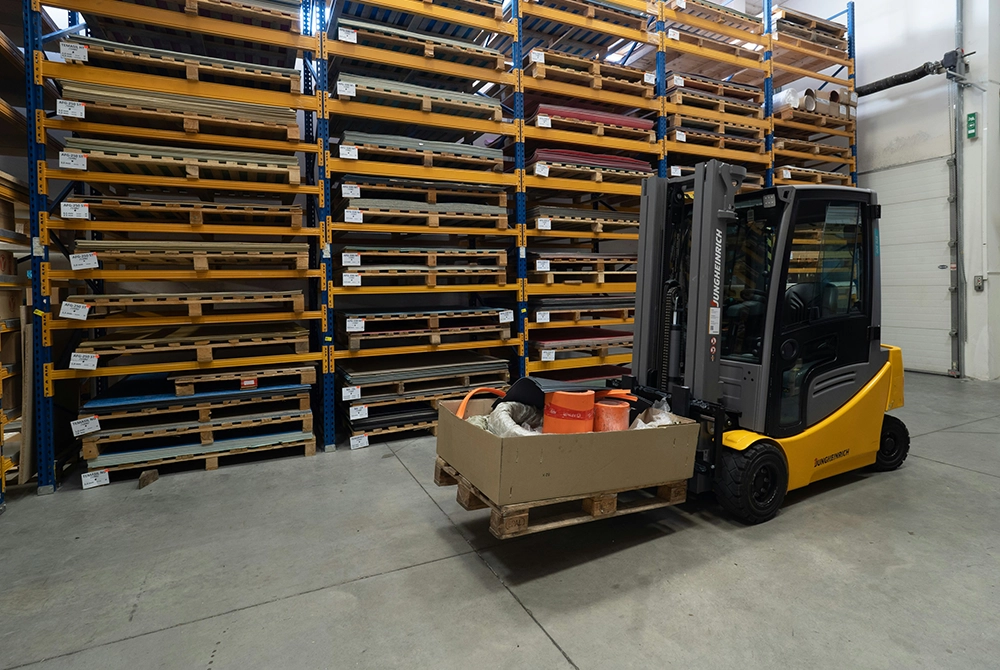Shelving systems matter in warehouse operations. Warehouse layout and racking systems have a direct and significant impact on overall productivity. When there is a balance of storage density with accessibility and safety, picking and movement is faster. Storage capacity is maximized by using the right amount of vertical space.
Optimizing shelving isn’t just about hardware, it’s about the people utilizing the system as well.
Types of Warehouse Shelving Systems
Selective Pallet Racking
Selective pallet racking is the most common racking system. Each pallet has its own slot this allows direct access via forklift to every pallet without having to move other.
This type of shelving system is best for warehouses with a wide variety of SKUs.
Pros: Direct access to each pallet, low costs, easy to install and adjust.
Cons: Less dense than other systems
Drive-In and Drive-Thru Racking
Drive-in racking is designed for high density storage where forklifts drive into lanes of stacked pallets. Pallets are stored on rails and accessed from one side only. This follows the last in, first out system (LIFO).
Drive-thru racking is similar to drive-in racking, but forklifts can enter from both sides of the lane. This allows for first-in, first-out rotation (FIFO). Which is beneficial for perishable goods or inventory that needs FIFO handling.
This type of shelving systems are vest for large volumes of identical products and function best in warehouses with low-turnover or seasonal inventory.
Pros: Maximizes space by eliminating aisles, high density warehousing
Cons: limited selectivity, requires careful forklift operation.
Push Back Racking
Push back racking is a high-density system where pallets are loaded onto carts that roll on inclined rails. New pallets push the previous ones back. This allows for multiple pallets deep on each level but pallets are loaded and unloaded from one side.
This system is best for warehouses with medium SKU counts and dense storage needs. With high turnover but not strict FIFO.
Pros: High-density storage with less space needed than drive in, up to 6 pallets deep per lane
Cons: Higher upfront costs and not FIFO
Cantilever Racking
Cantilever racking is a racking system with horizontal arms that extend from a central column, ideal for irregularly shaped, awkward, or long items like lumber or pipes. There are no vertical obstructions on the front so items can extend past the rack.
Cantilever racking is best for construction or industrial goods. Warehouses whose inventory include lumber, pipes, metal bars, sheet materials or furniture often use this system.
Pros: Easily adjustable arms, open front design for awkward items.
Cons: Is really only efficient for specific supplies and industries
Shelving for Small Parts
Shelving for small parts is designed for hand-picked items, typically in smaller bins or boxes. This is non-palletized shelving units for storing tools, parts of inventory. Often this is used in order fulfillment or packing stations.
This type of shelving is ideal for ecommerce and picking and packing operations. With small parts, fasteners, tools, components in assembly or repair areas.
Pros: Ideal for order picking, great for kitting stations or ecommerce order packing.
Cons: Is only best for small parts
Factors to Consider When Choosing Warehouse Shelving
- Load capacity and SKU profiles.
- Turnover rate and inventory flow (FIFO vs LIFO).
- Available space and ceiling height.
- Equipment compatibility (e.g. forklift clearance).
- Safety regulations and compliance (e.g. OSHA, RMI specs).
- Flexibility and future scalability.
Creating Efficiency with Flexible Staffing
Even the best shelving system requires efficient labor to keep operations running.
Flexible staffing solutions like Bacon help warehouses scale up or down for demand without compromising quality. Traditional temp agencies near you can provide temp labor but cannot provide warehouse temp staffing that can be scaled to meet real time demand.
Staffing platforms provide access to temporary warehouse workers who are background checked and rated. Warehouse job apps help warehouses find pickers and packers or find warehouse staff.
Staffing platforms can staff warehouse shifts during peak season or consistently all year round. Warehouses can supplement core teams with skilled workers via warehouse job apps to keep fulfillment timelines on track.
Build a Smarter Warehouse from the Ground Up
Aligning shelving types with operational goals is important. Optimal storage and flexible labor create the maximum efficiency. With staffing apps warehouses can find warehouse workers to utilize the optimized layout of the warehouse.
Evaluate both your physical infrastructure and your warehouse strategy.
Need to flex your warehouse team without sacrificing efficiency? Discover how Bacon helps warehouses like yours hire picking and packing workers







